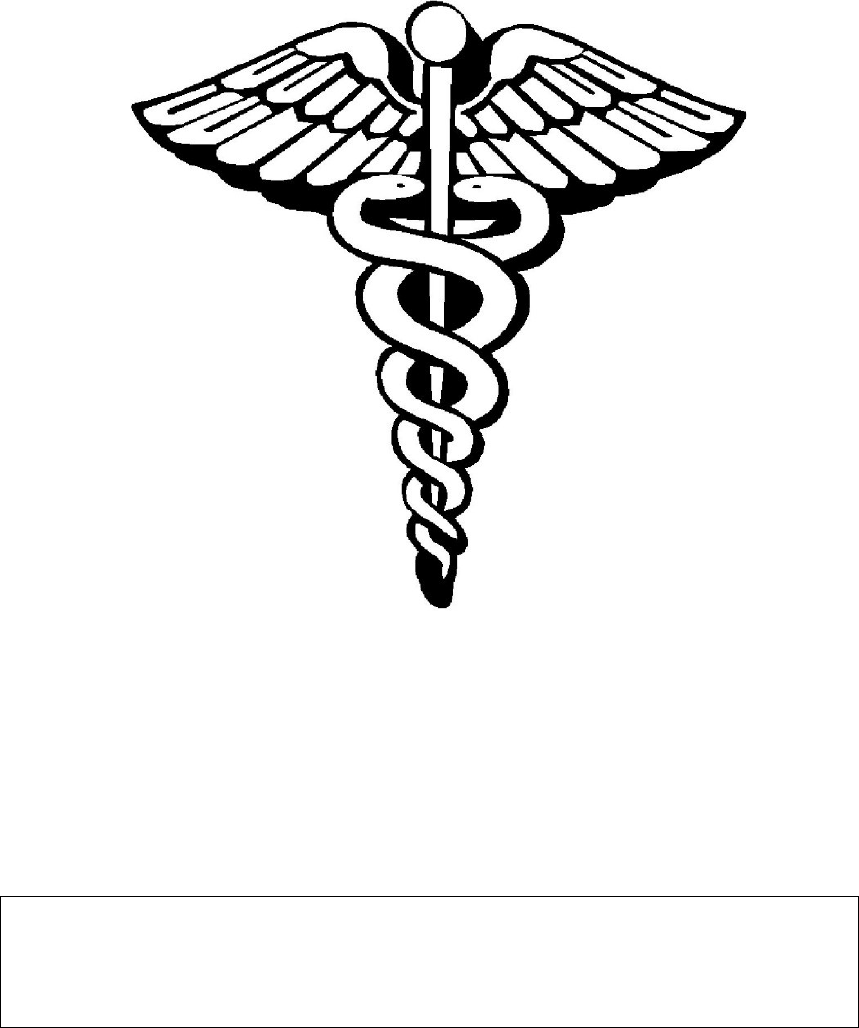
The West Point
Pre-Medical School Scholarship Program
DISCLAIMER: This guide is intended to assist cadets at the United States Military Academy
pursuing the medical school option. Information in this document may change over time. Questions
should be directed to the medical school advisor in the Office of the Dean.
Last updated: 24 August 2020

Introduction
In accordance with Army Regulation (AR) 601-141 the Department of Defense permits
two percent of each West Point graduating class to attend medical school under military
sponsorship. The Superintendent is responsible for the selection of cadet applicants for the
Uniformed Services University (USU) and Health Professions Scholarship Program (HPSP). The
management of this process is accomplished through the West Point Pre-Medical Scholarship
Program, coordinated by a pre-medical advisor in the Office of the Dean in concert with faculty
from the Department of Chemistry and Life Science (CLS). This document provides information
for cadets interested in attending medical school directly from the United States Military Academy
(USMA).
Core Competencies
The American Association of Medical Colleges (AAMC) governs the medical school
application process for allopathic schools in the United States and Canada. Core competencies
prescribed by the AAMC include proficiency in pre-professional activities, thinking and reasoning,
and science competencies. Cadets demonstrate aptitude in these areas through academic
success, performance on the
Medical College Admission Test® (MCAT), clinical exposure,
research, volunteer work and community service. In addition to meeting program requirements,
cadets must perform well in the four pillars of academy life: academic, military, physical and
character. Cadets are appealing applicants because the qualities and attributes that make them
successful at West Point closely align with the core competencies sought by medical schools.
AAMC Core Competencies
Pre-professional Activities
Thinking and Reasoning
Science Competencies
Capacity for improvement
Critical thinking
Human behavior
Cultural competence
Quantitative reasoning
Living systems
Ethical responsibility
Scientific inquiry
Oral communication
Written communication
Reliability and dependability
Resilience and adaptability
Service orientation
Social skills
Program Requirements
An annotation in AMS identifies members of the scholarship program. In coordination with
the USMA pre-medical advisor, Department Academic Counselors (DACs) enter cadets into the
program after majors have been selected. Participation in the scholarship program is based on
academic performance as well as commitment to the requirements detailed below. It is important
to note that the scores/grades serve to meet absolute minimum requirements; attaining these
metrics does not guarantee endorsement to attend medical school. Average scores of
matriculants are considerably higher than the minimums and gaining acceptance to medical
school generally requires much stronger numbers.
Pre-Medical Program Requirements
Cumulative Grade Point Average (CQPA) ≥ 3.2
Biology-Chemistry-Physics-Math (BCPM) average ≥ 3.2
MCAT score ≥ 500
MCAT section scores ≥ 124

At least 50 hours of clinical exposure (healthcare volunteer work and shadowing)
Participation in research
Selfless service demonstrated by volunteer activities and community work
Course Requirements
Cadets may enter the program through any major. The pre-medical program course
requirements are listed below. Undergraduate course requirements for medical schools vary and
cadets are strongly encouraged to explore specific recommendations for their schools of interest.
When pre-medical courses are oversubscribed, the final determination for admission will be made
by the CLS department with input from the pre-medical advisor in the Office of the Dean. Factors
for consideration will include commitment to the pre-medical program, participation in the West
Point Pre-Medical Society (WPPMS), progress in meeting program requirements and reaching
Academic Program Score Cumulative (APSC) PEG points for each course. The USMA course
requirements and PEG points are as follows:
Medical Program Course Requirements
USMA Course Designation(s) APSC PEG point
General chemistry with lab – 1 year CH101*/102* N/A
Organic chemistry with lab – 1 year CH383/384 3.0
Biochemistry – 1 semester CH473 3.2
Advanced biology with lab – 1 semester CH375 3.0
Physiology with lab – 1 semester CH387 3.2
Physics with lab – 1 year PH205*/206* N/A
Calculus – 1 semester MA104* N/A
Probability and statistics – 1 semester MA206* N/A
English – 1 year EN101*/102* N/A
*Cadets may take advanced versions of these courses
Additional Academic Opportunities
Courses
Beyond the course requirements outlined above, additional academic opportunities are
available. These include individual research courses, healthcare professions seminars, human
anatomy, a summer school program for rising seniors, and other courses that provide additional
depth in pre-medical disciplines.
According to AAMC, over 85% of medical school applicants perform research. At West
Point, participation in research is mandatory for pre-med cadets and individual research courses
are available through various departments. CLS offerings include CH289, CH290, CH389,
CH390, CH391, C392, CH489, CH490, CH491 and CH492. These individual research courses
have two primary goals. The first is the opportunity for cadets to understand the scientific method
in depth while becoming better problem solvers and developing leadership skills. The second
goal is to present scholarly research at conferences and author publications. Meeting these
goals significantly enhances medical school applications and chances for success in the
admissions process.
The Healthcare Professions Seminars (CH291 and CH292) help aspiring physicians
understand aspects of the medical profession that transcend their coursework, including service
as an Army doctor. The classes also assist with preparation for the medical school application
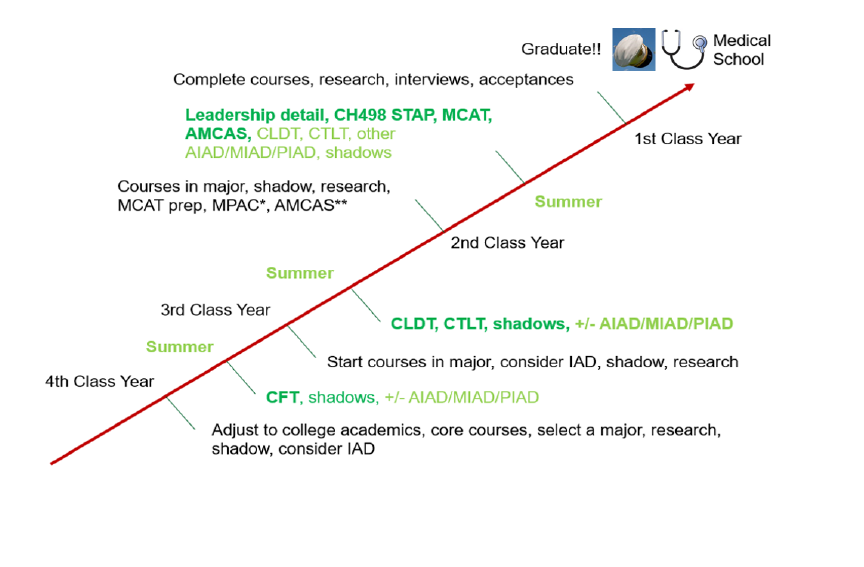
process. The Human Anatomy (CH460) course is offered to second semester seniors who have
applied to medical school. It is an upper level anatomy class designed to facilitate the transition
to professional schooling. Advanced Study in Pre-medical Science (CH489) is a Summer Term
Academic Program (STAP) course that provides endorsed candidates the opportunity to finalize
preparations for the MCAT and complete medical school applications.
Several other courses are available to provide depth in pre-medical disciplines. The
MCAT includes a section on Psychological, Social, and Biological Foundations of Behavior and
the Department of Behavioral Sciences and Leadership (BS&L) offers valuable courses including
Biological Psychology (PL390) and Introduction to Sociology (PL371). Life Science majors obtain
depth by taking the following electives: Microbiology (CH457), Cellular Biology (CH385) and
Genetics (CH388). Depth courses outside a major are offered on a space available basis. All
departments give priority for enrollment to their majors; decisions regarding admission to non-
majors are made by the departments teaching the classes.
Advanced Individual Academic Development (AIAD) Programs
The CLS department coordinates AIADs specifically designed for medical school
aspirants. These programs fall into three categories: research, clinical and combined. The pure
research programs provide opportunities for concentrated investigation at outside laboratories.
Cadets expand their understanding of science, increase opportunities for publication and
strengthen their medical school applications. Clinical programs are conducted at military medical
centers or civilian teaching hospitals. Participants shadow healthcare providers in a variety of
settings including clinics, procedure rooms and operating theaters. Combined programs,
generally conducted at Army facilities, provide time for both laboratory and clinical endeavors.
Timeline
The pre-medical timeline provides a useful framework for the delivery of comprehensive
information on the various steps required to earn a scholarship to attend medical school. These
components will be addressed chronologically. An overview of the process is depicted below:
*Medical Program Advisory Committee ** American Medical College Application Services
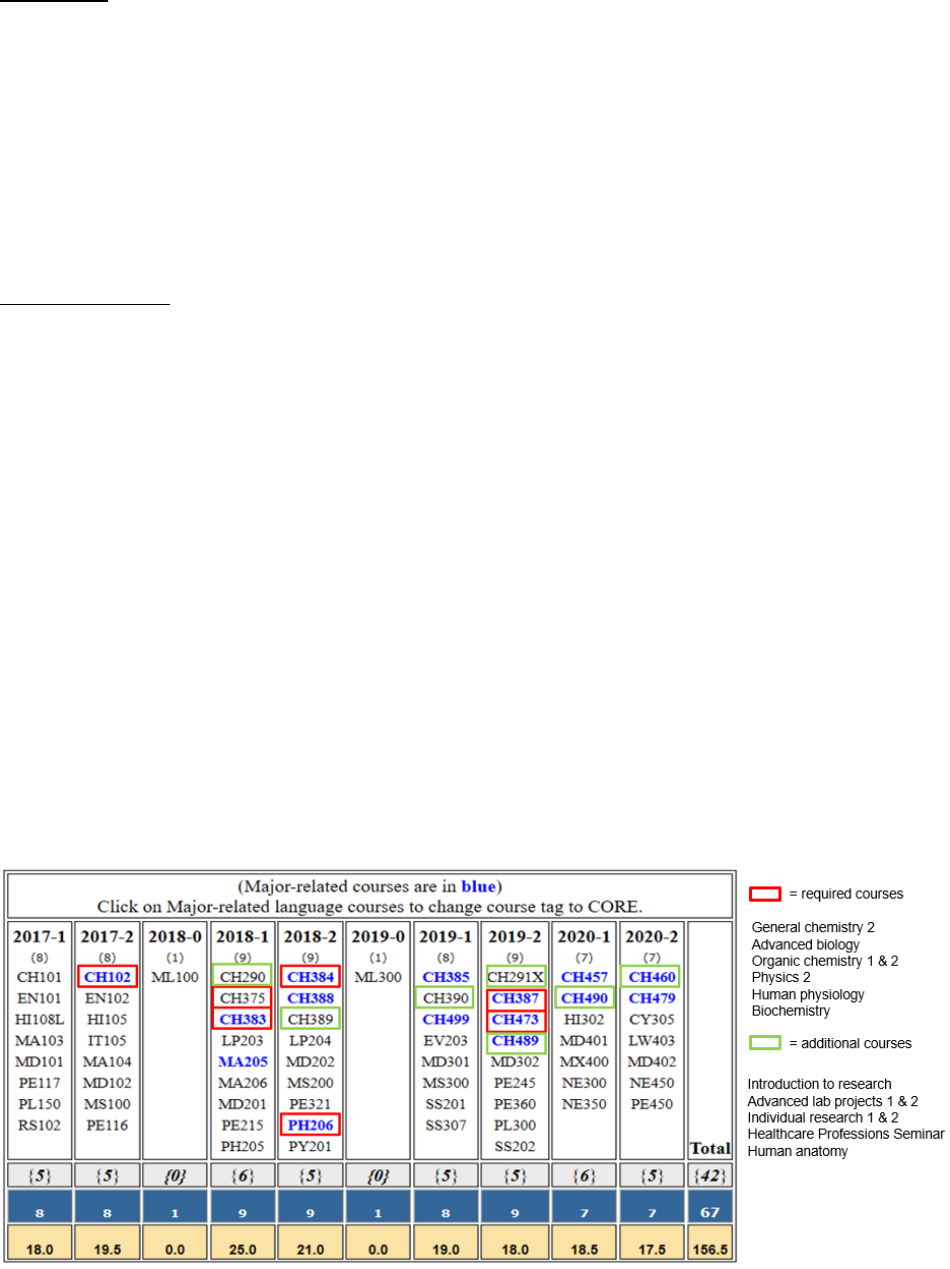
Fourth class (Plebe) year
Academics
In 2019, the average GPA for applicants accepted to medical school was 3.72. The
average non-science GPA was 3.81. While acceptance to medical school is not all about grades,
establishing a firm foundation in academics in order to attain a high Cumulative Quality Point
Average (CQPA) is extremely important. Concentration on academics in the first year is critical.
During the first semester, cadets are strongly encouraged to develop good study habits and
optimize performance across all pillars. The first-year curriculum consists of core courses and
pre-med cadets are advised take CH102 during the second semester of plebe year. While it
is not an absolute requirement, completing chemistry during the first year facilitates scheduling
during the ensuing semesters.
Selecting a Major
One of the most commonly asked questions by pre-med students is, “What should I
choose for a major?” Cadets interested in attending medical school can major in any discipline
they choose; however, they must ensure that all necessary pre-medical course requirements are
met. When selecting a major, it is important to consider “passion and talent.” In other words,
what academic pursuits excite you (passion) and what are you good at studying (talent)? These
considerations should guide selection of a major. West Point will likely provide your only
extended undergraduate experience so select a discipline that provides courses that truly interest
you! Double majors and minors are not encouraged. The additional time is better spent doing
research and engaging in other required pre-med activities like shadowing, volunteering and
community service.
Most aspiring physicians at USMA major in Life Science. This major appeals to their
passion for science and facilitates MCAT preparation by providing depth in biology courses. In
addition, the required premedical courses are all embedded in the major. Other common majors
include Kinesiology, Environmental Science, Psychology and Mechanical Engineering.
Consultation with the Redbook is advised because requirements for majors change year to year.
The following are sample Eight-Term Academic Programs (8TAPs) from recent medical school
scholarship recipients:
Life Science
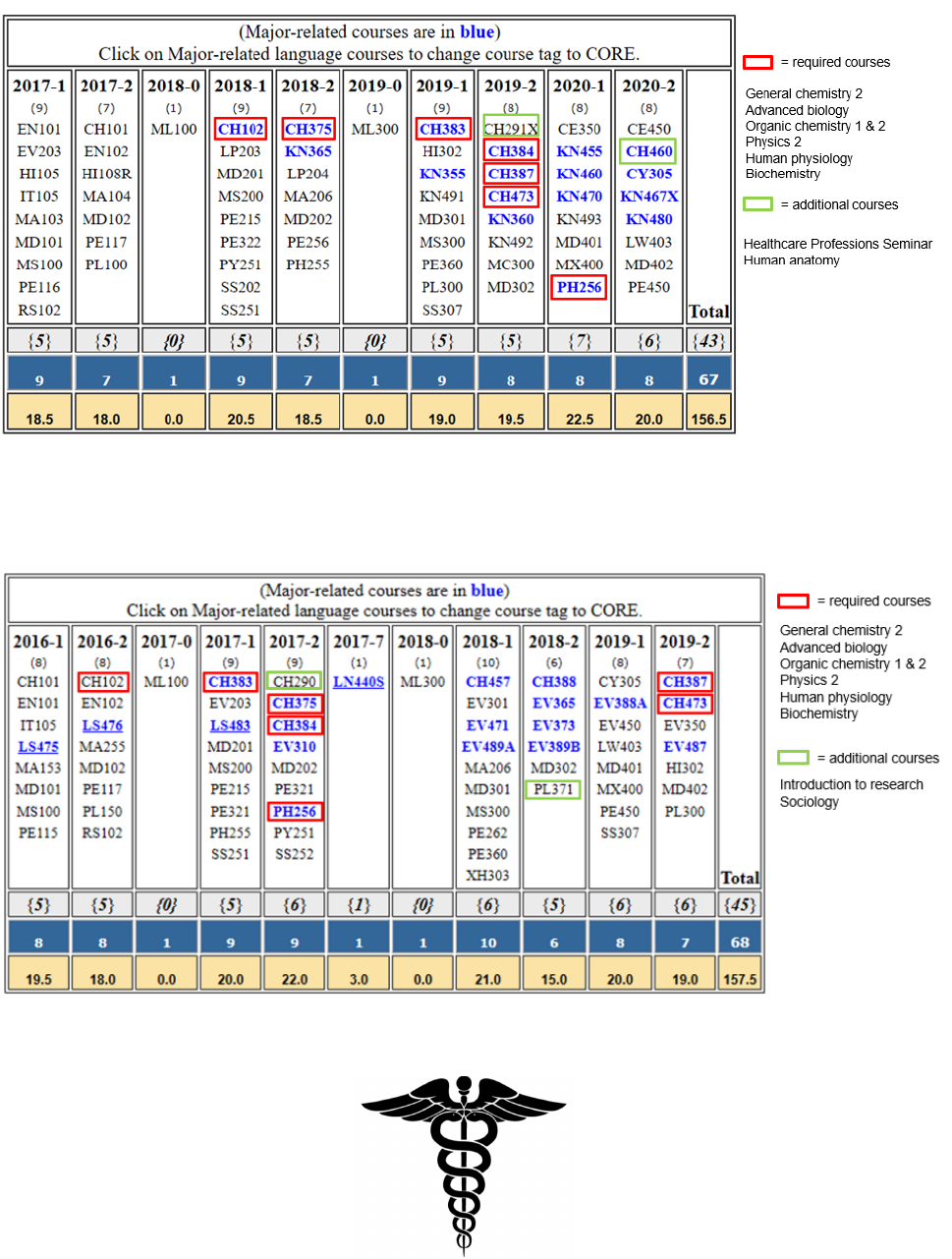
Kinesiology
Environmental Science
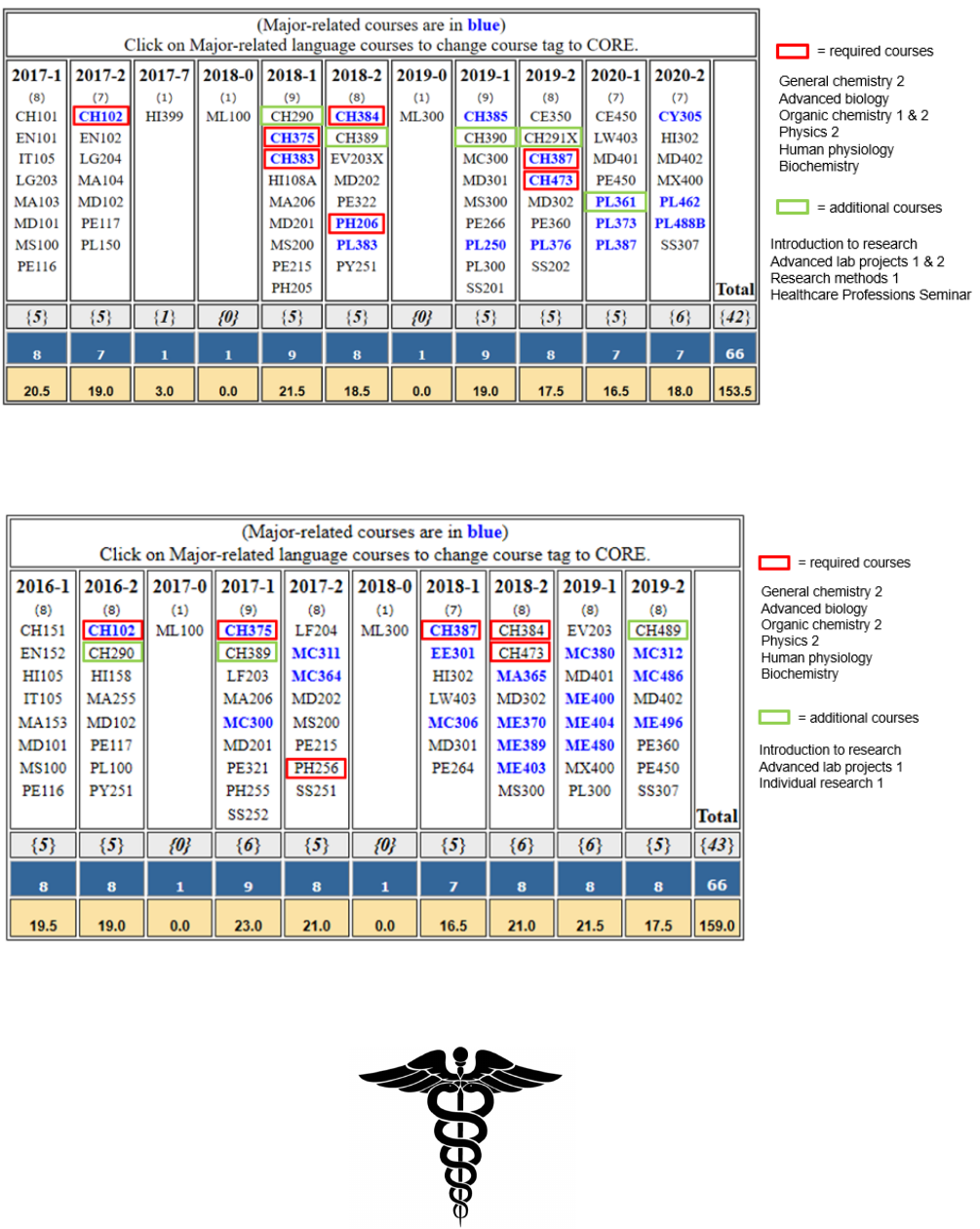
Psychology
Mechanical Engineering
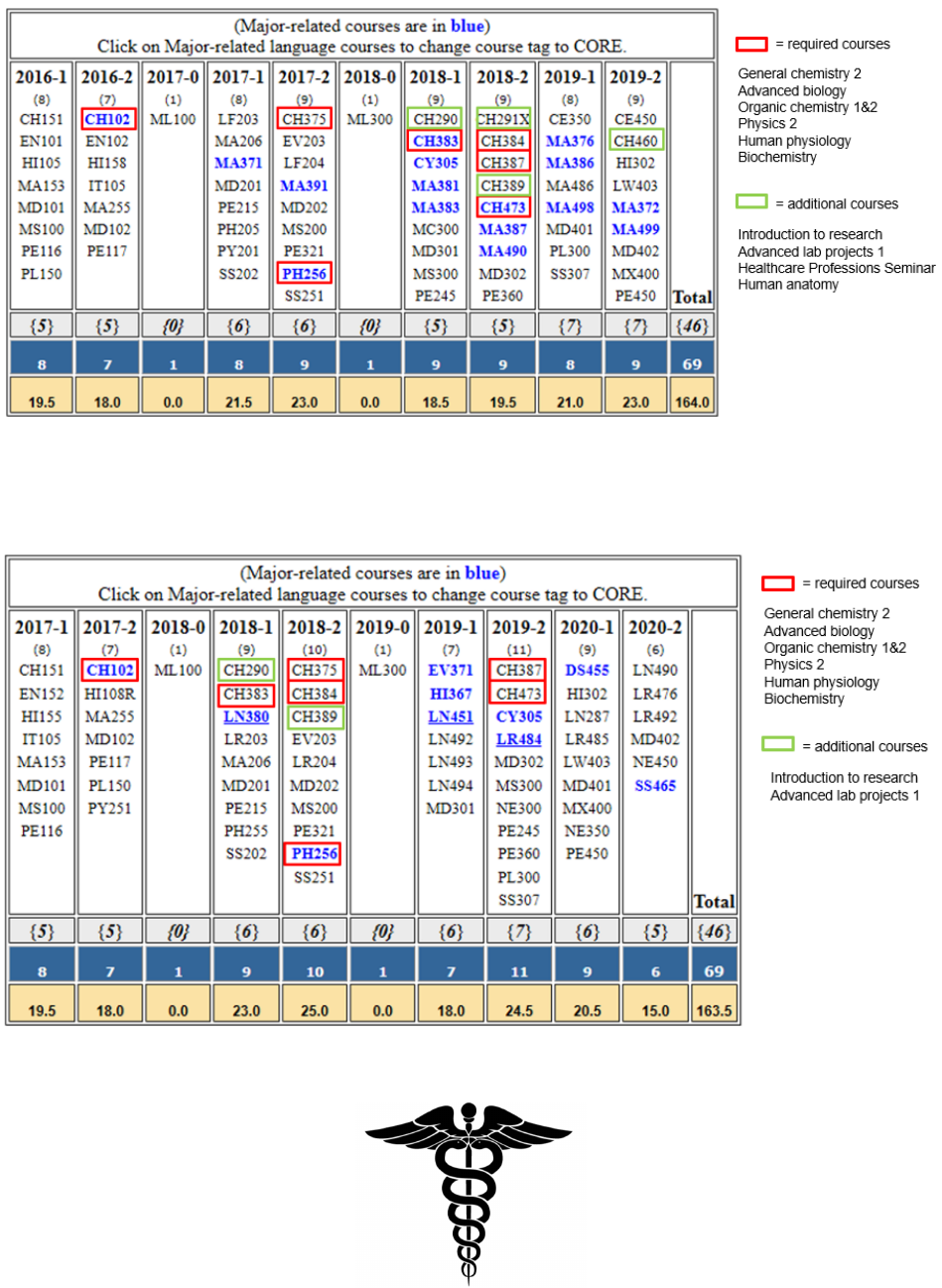
Mathematics
Foreign Language

West Point Premedical Society (WPPMS)
The WPPMS provides opportunities for cadets to share interests, attend talks by guest
speakers, join in volunteer experiences, and pursue leadership positions. This cadet run club
operates under the auspices of a faculty member in the CLS department in close coordination
with the USMA pre-medical advisor. It is imperative that all pre-med cadets join the WPPMS.
Since cadets enter the pre-med scholarship program through a variety of majors, the WPPMS
serves as the primary conduit for information flow. All important events are coordinated through
the WPPMS, ranging from briefings regarding the pre-med program and shadowing opportunities
to MCAT preparation and selection by the Medical Program Advisory Committee (MPAC) to
attend medical school.
Research
Most research projects are performed by teams and plebe year is an excellent time to join
one of them. The benefits of research are discussed above (Additional Academic Opportunities,
Courses). These endeavors can be performed independently or as part of a course. Early entry
into the research arena provides time for training in specific techniques and accumulating
experience while establishing leadership opportunities for the future. It also enhances prospects
for presentations and publications.
Volunteerism and Community Service
The medical profession demands selfless service to others. One way that admissions
committees judge applicants in this core competency is through their commitment to volunteer
activities and community service. There are a wide range of extracurricular activities at West
Point that fall into this category and cadets are encouraged to participate in organizations and
endeavors that interest them. Examples include Habitat for Humanity, Special Olympics, Unified
Sports, scouting, tutoring, etc.
Clinical Exposure
Most medical school place a high premium on exposure to clinical medicine. In an era
when physician burnout and dissatisfaction with the profession are high, shadowing and other
clinical experiences are thought to provide a more realistic introduction to the rewards and
challenges of a career in healthcare. Without clinical exposure, it is highly unlikely that an
applicant will get accepted to medical school. A limited shadowing program exists at Keller Army
Community Hospital (KACH) and cadets are encouraged to sign up through the WPPMS.
However, the volume of experience attainable at KACH is woefully inadequate and medical
school applicants are urged to gain additional exposure while home on break, through the Walter
Reed spring trip and through AIADs.
Third class (Yearling) year

Advanced Individual Academic Development Programs (AIADs)
Several departments offer AIAD programs that provide opportunities for pre-med cadets.
An overview of the CLS offerings is provided above (Additional Academic Opportunities, AIADs).
Beyond the AIADs specifically targeted for medical school aspirants, there are other beneficial
programs. For example, the Department of Physics sends cadets to national laboratories
including Los Alamos, Lawrence Livermore and Sandia. A performance psychology internship is
sponsored by the Department of Behavioral Science and Leadership (BS&L). The Department of
Social Sciences provides overseas medical experiences through international organizations like
Projects Abroad and Cross Cultural Solutions. Cadets work at the Department of Health and
Human Services through a program coordinated by the Department of Geography and
Environmental Engineering. Offerings from the various departments differ year to year and
interested cadets should contact the respective department AIAID coordinators to explore
options.
Academics
Cadets start their premedical coursework during the second-class year. Typical courses
include advanced biology (CH375), organic chemistry (CH383/384) and physics (PH205/206).
Yearlings may take the first semester of Healthcare Professions Seminar (CH291), a 1.0 credit
elective course that addresses topics of importance in the world of medicine.
Clinical Exposure
Yearling year is an ideal time to continue gaining exposure to medicine through
shadowing and other clinical opportunities. For those who did not start shadowing during plebe
year, it is extremely important to begin. This can be done independently or through AIAD
programs. These shadowing opportunities help inform the decision to become a physician. If
medicine is not the right path, it is good to figure that out as early as possible. Conversely, if
clinical exposure reinforces the decision to enter the healthcare profession, having a variety of
experiences will strengthen one’s medical school application and improve chances for success.
Most cadets have leave time during the summer. All are encouraged to set up shadowing
opportunities while away from West Point. Cadets should try to establish relationships with
providers who can be visited throughout the undergraduate years. These repeat encounters
provide opportunities to receive clinical letters of recommendation that are required by some
schools and encouraged by others. Exposure to patients is the key and varied experiences are
ideal. Cadets should not narrow shadowing experiences to one or two specialties. Students
interested in surgery should spend time with primary care providers, medical specialists,
radiologists, etc., in addition to surgeons. Future medical school applicants should carve out time
to work with nurses, physician assistants, physical therapists, and other healthcare personnel.
Anything that puts applicants in contact with patients and provides education about healthcare is
worthwhile. The more clinical exposure an individual has, the stronger the application will be.
Civilian applicants often have thousands of hours working as paramedics, emergency medical
technicians, scribes and health aids. While cadets cannot attain massive numbers of clinical
hours due to the demands of academy life, it remains important to accumulate a significant
amount of clinical exposure.
Research
Hopefully, most yearlings started working with a research group and/or advisor during
their first year (see Plebe Year, Research). If so, they should continue working with their partners
and principal investigators. If one’s interest has been sparked by other projects and/or
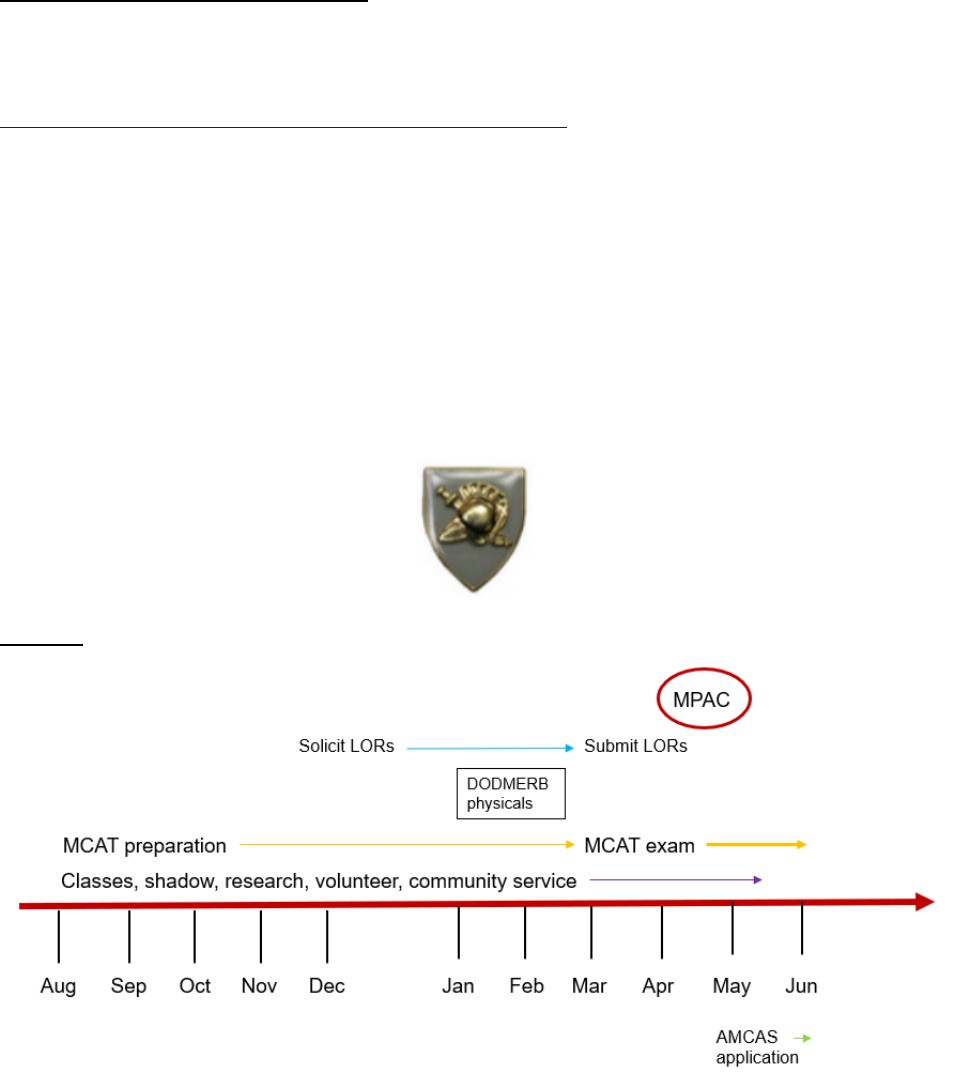
professors, those areas of study should be explored. For cadets who have not yet entered the
research arena, this is the time to start. Consider bench (basic science) research, clinical
research (often performed with physicians from KACH or USU), translational research or studies
in other disciplines of interest. These endeavors can be pursued with mentors from any
department. Projects should create new knowledge and/or use existing knowledge in a new and
creative way to generate new concepts, methodologies and/or understandings. A record of
publications and presentations is not an absolute requirement for all medical schools; however, it
greatly enhances applications and may be required for acceptance to top tier institutions.
Volunteerism and Community Service
These endeavors should continue during the third-class year. Cadets are encouraged to
serve in leadership positions.
Cadet Leader Development Training Plus One (CLDT + 1)
Cadet Leader Development Training marks the culmination of West Point’s tactical and
leader development instruction in the field and serves as a capstone military training event prior
to commissioning as a second lieutenant. The CLDT+1 program enables rising second class
cadets to attend CLDT and meet one other requirement (Cadet Troop Leader Training (CTLT) or
AIAD/MIAD/PIAD). A finite number of slots are available, and cadets are selected based on
success across all pillars. Yearlings are invited to apply for the program in November and
selections are announced by the end of the first semester. Participation in the CLDT+1 program
creates time for the Pre-Med STAP program the following summer when cadets finalize medical
school applications and MCAT preparations.
Second class (Cow) year
Timeline
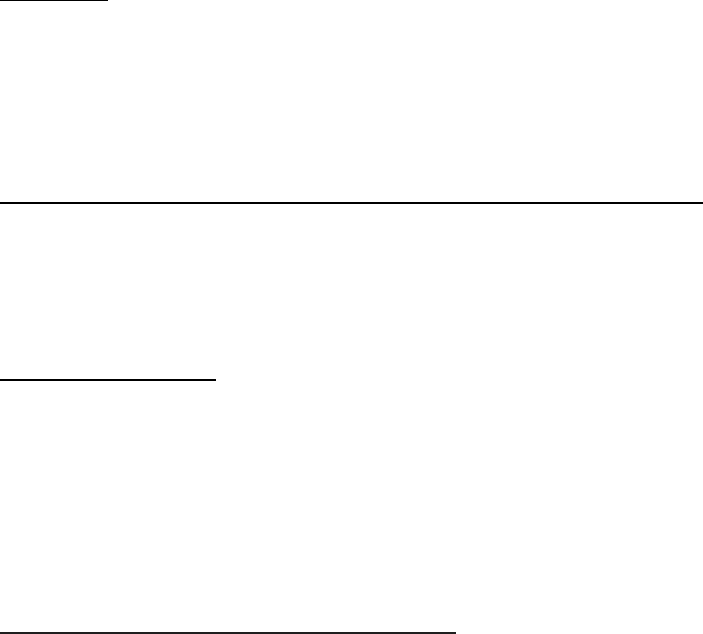
Academics
Cadets complete their premedical coursework during the second-class year in anticipation
of taking the MCAT. Typical courses include physiology (CH387) and biochemistry (CH483);
both classes are taught during the second semester. Cows may take the first and second
semesters of Healthcare Professions Seminar (CH291/292). The second semester course
(CH292) helps guide aspiring physicians through the medical school application process.
AIADs, clinical exposure, research, volunteerism and community service
These endeavors, detailed in the sections above, continue into cow year. Schedule
permitting, AIADs are available during the summer. Shadowing, research, volunteerism and
community service should continue throughout the second-class year. Premed cadets often
assume senior positions in research teams and volunteer organizations.
Pre-medical Physicals
A commissioning physical examination is required for all cadets prior to graduation. The
pre-medical physical includes a few items beyond the requirements of the basic commissioning
examination. The pre-medical physical doubles as the commissioning physical; only one
examination is required. Cadets endorsed to attend medical school will be advised of the timing
of the physicals. Examinations are performed by healthcare providers at the Cadet Health Clinic.
Copies of the completed exams must be delivered to the pre-medical advisor in the Office of the
Dean for distribution to the appropriate agencies.
The Medical College Admission Test® (MCAT)
Overview
The Medical College Admission Test® is a standardized, multiple-choice examination
administered by the AAMC. It is designed to assess problem solving, critical thinking, and
knowledge of natural, behavioral, and social science concepts and principles prerequisite to the
study of medicine. The test provides a consistent way to compare applicants from a wide range
of undergraduate colleges and universities. In April 2015, the AAMC launched
the current version of the MCAT exam. Scores are reported in four sections:
• Biological and Biochemical Foundations of Living Systems
• Chemical and Physical Foundations of Biological Systems
• Psychological, Social, and Biological Foundations of Behavior
• Critical Analysis and Reasoning Skills
Successful completion of the MCAT is a required element of the West Point Pre-Medical
Scholarship Program. USU, HPSP and almost all U.S. medical schools require submission of
MCAT exam scores. The total score ranges from 472 to 528. The absolute minimum scores to
receive a scholarship are 500 overall and 124 on each section; however, gaining acceptance to
medical school usually requires considerably higher numbers. A score of 510 is the generally
accepted cutoff to be competitive for medical school. The average score nationwide of medical
school matriculants in 2019 was 511.6.
The key to success on the MCAT is preparation. Historically, cadets have underprepared
and underperformed on the exam, limiting their opportunities at many medical schools.
Conversely, those who scored well were accepted by many of the best schools in the country.
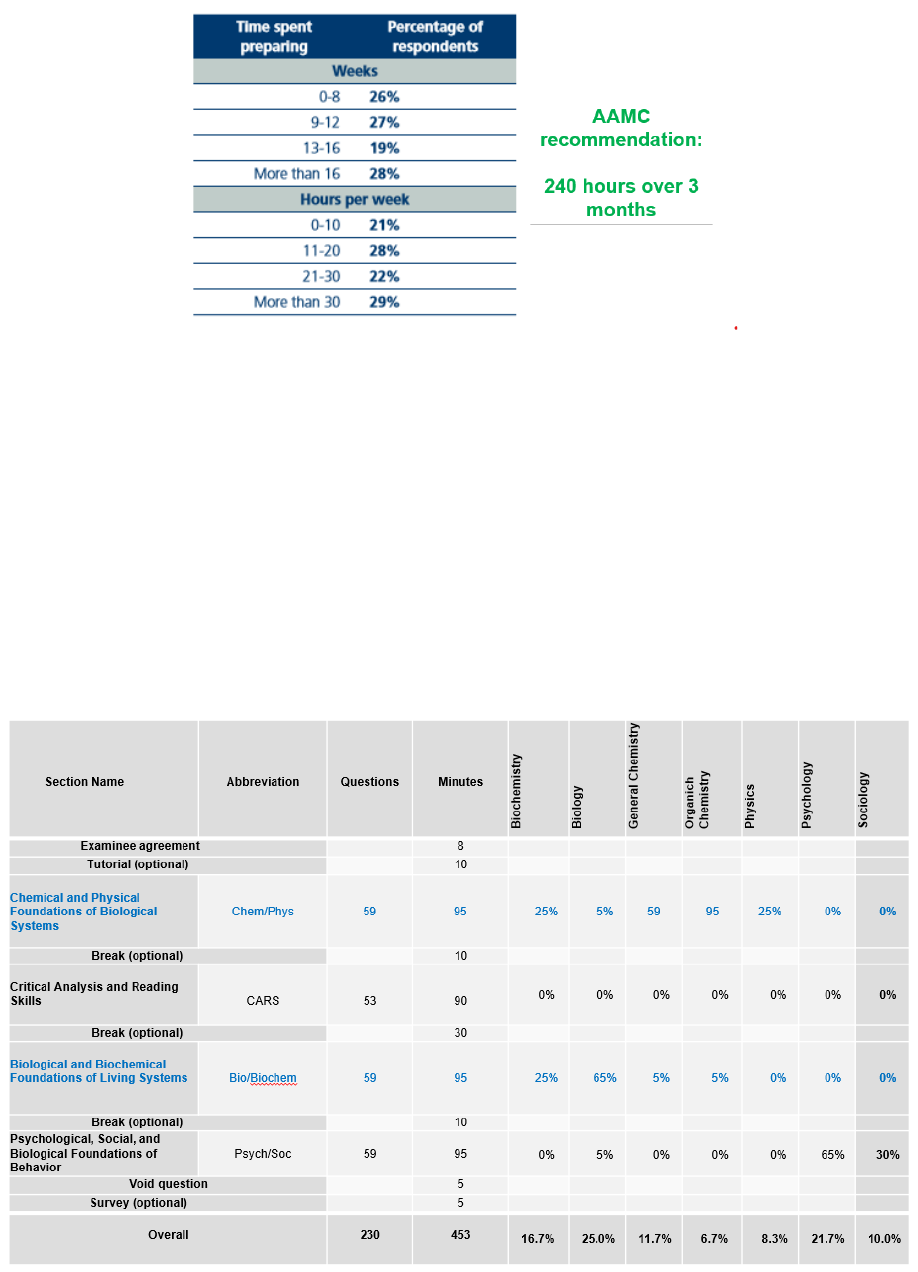
AAMC data demonstrate that the largest number of applicants who take the MCAT study more
than 30 hours a week for over 16 weeks.
Preparation Materials
There are many companies that provide test preparation services. These include Kaplan,
Exam Krackers, Princeton Review, Next Step, Sterling Test Prep, Altius, etc. In addition, AAMC
provides a variety of study resources including full length practice tests. Since AAMC writes and
administers the MCAT, applicants are encouraged to use their resources with supplementation as
needed from any of the myriad companies that offer materials.
Test Format
The standard MCAT is a 7.5-hour computerized test divided into four sections. In 2020,
the test was shortened to accommodate challenges presented by the COVID-19 pandemic. The
exam is presented in the order depicted and includes the components detailed below:
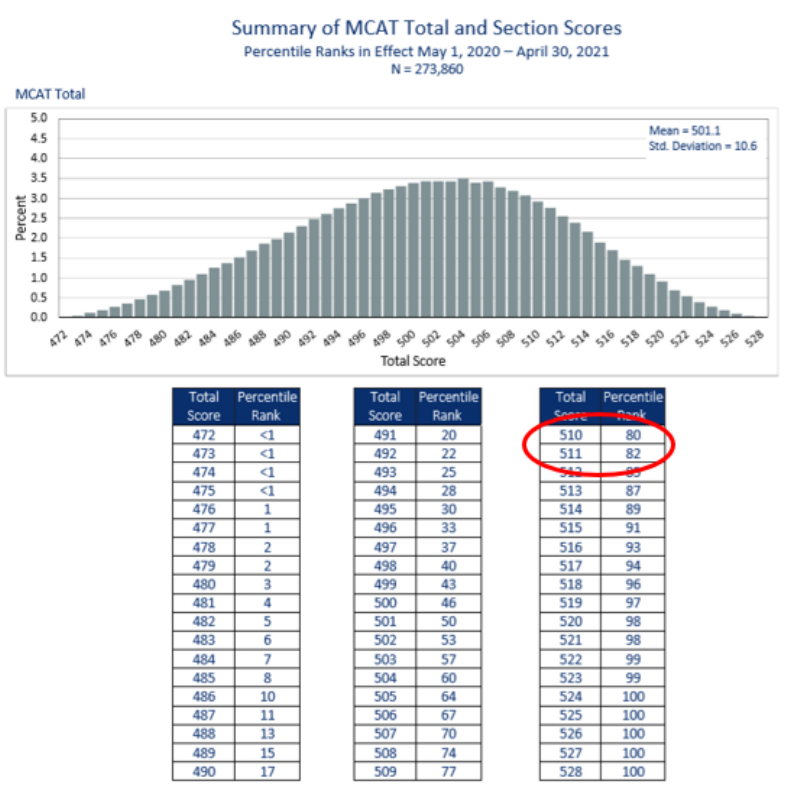
Scoring
Raw scores: Scoring is based on the number of questions answered correctly. The raw
score reflects correct answers only; a wrong answer is scored the same as an unanswered
question. There is no additional penalty for wrong answers, so it is advisable to make an
educated guess when the occasion arises. The raw scores from each of the four sections are
converted to a scaled score ranging from 118 (lowest) to 132 (highest).
Scaled Scoring: The conversion of raw scores to scaled scores compensates for small
variations in difficulty between sets of questions. The exact conversion of raw to scaled scores is
not constant because different sets of questions are used on different exams. Two students of
equal ability are expected to get the same scaled score, even though there might be a slight
difference between the raw scores each student obtained on the test.
Percentiles: The percentile ranks reflect the percentage of test takers who received the
same scores, or lower scores, on the exam. They provide a comparison to the scores of other
examinees. On May 1
st
each year, the percentile ranks are updated using data from one or more
testing years. These annual updates ensure that the percentile ranks reflect current and stable
information about the scores. As a result, changes in percentile ranks from one year to another
reflect meaningful changes in the scores of examinees, rather than year-to-year fluctuations.
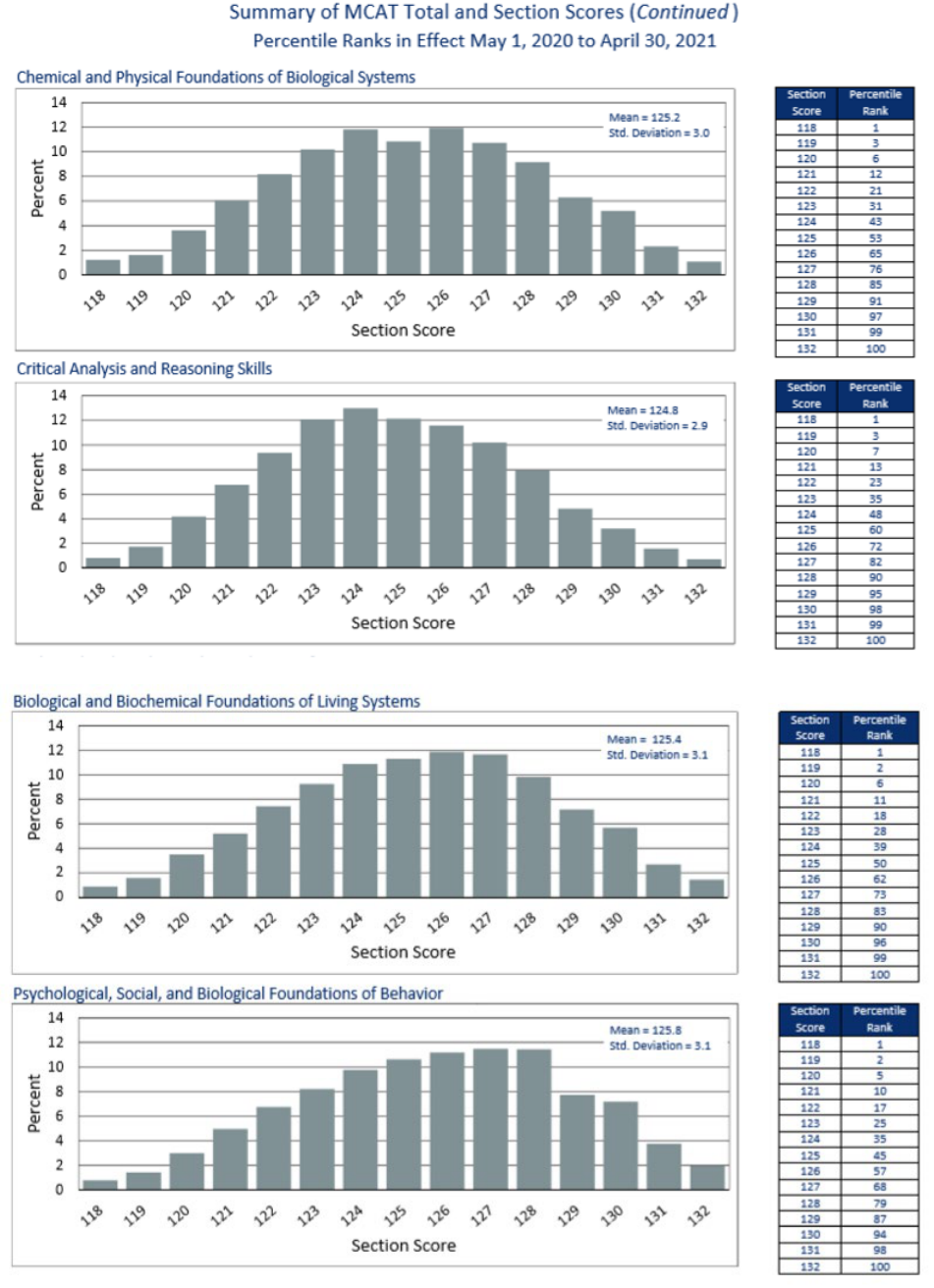

Timing
Cadets are strongly encouraged to take the MCAT no later than spring break of their cow
year. This provides an opportunity to retake the examination in the event of a low score. The
latest date a cadet is permitted to take the MCAT is mid-June (exact test dates vary year to year)
of the cow year. Applicants who take their initial examination in May or June will not be afforded
an opportunity to re-take the exam. Cadets who do not meet the cut-off scores (500 overall and
124 on each section) will be eliminated from the scholarship program. While they can attend
medical school in the future, those cadets are obligated to serve in the Army prior to pursuing
their studies.
Medical Program Advisory Committee (MPAC) Selections
Overview
The Medical Program Advisory Committee convenes a board each spring to assess
individual readiness for application to attend medical school. The committee can select up to two
percent of the second-year class for endorsement to attend medical school directly from USMA.
The exact number is calculated based on the number cadets in the class during the second
semester of cow year. The exact timeline and application requirements are disseminated through
the WPPMS. A briefing is held at the beginning of the second semester to explain the process in
detail and answer questions.
Participants
The MPAC board is composed of the Dean’s Pre-Medical Advisor and representatives
from the Department of CLS, KACH, USCC, Uniformed Services University (USU) and the Health
Professions Scholarship Program (HPSP). Prior to the interviews, the board reviews packets that
include the materials detailed below. During the interview, board members ask a series of
questions to gain a better understanding of each cadet’s suitability and readiness to become an
Army physician.
Required Documents
Application: This includes demographic information, CQPA, grades in designated subjects and
specific questions.
Personal Statement: The essay is limited to 5,300 characters (including spaces). This exact
format is used in the AMCAS medical school application. Assistance is permitted and applicants
are strongly encouraged to have their statements reviewed for errors in spelling, grammar,
punctuation, etc.
Resume: A specific format is provided for applicants. Cadets should not include honors,
activities, etc. from their high school years unless they are still actively involved in the
activity/organization (example: Special Olympics – 2012-2018).
Letters of Recommendation (LOR): Applicants are required to submit five to seven letters of
recommendation. At least two letters must be from faculty in the Department of Chemistry and
Life Science. Letters should be addressed “To Whom It May Concern.” A detailed memorandum
on letters of recommendation is provided as part of the MPAC preparation materials.
Clinical exposure/shadowing log: Cadets are asked to list medically related shadow and volunteer
activities. The log includes the experience/specialty (example: general surgery), mentor (Dr.
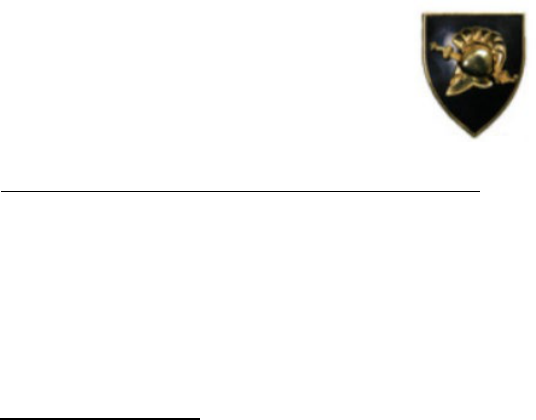
Smart), estimated number of hours each day, location (example: KACH) and a brief description of
the experience.
W
ork and Activities: This section provides the opportunity to highlight up to fifteen work
experiences, extracurricular activities, AIADs/MIADs/PIADs, research activities, chain of
command positions, awards, honors, or publications that applicants want to bring to the attention
of the MPAC and medical schools. It follows the exact format used by AMCAS. Applicants are
encouraged to consider the transformative nature of the experience, the impact made while
engaging in the activity and the personal growth experienced as a result of participation.
C
adet Record Brief (CRB) with Company Tactical Officer (TAC) comments supporting medical
school attendance: Each packet includes a CRB with comments from the Company TAC.
Cadets are required to speak with their TACs to let them know that they will be applying to the
MPAC. The Dean’s office solicits the CRB with TAC comments for the board.
Tr
anscript: The Dean’s office obtains the transcript.
E
ndorsement
Fol
lowing the interviews, the committee announces provisional endorsements pending
spring semester grades and successful completion of the MCAT. If there are more qualified
cadets than available slots, an Order of Merit List (OML) is created to designate alternates.
Endorsed cadets are re-evaluated in August. Those who meet established HPSP requirements
(CQPA/APSC = 3.2, MCAT = 500, section scores ≥ 124) remain endorsed. Those who fail to
meet these criteria are re-evaluated by a sub-committee of the MPAC. Individuals originally on
the alternate list can receive an endorsement if slots become available following the re-evaluation
process or following voluntary withdrawal by an endorsed cadet. The Dean’s Pre-Medical
Advisor writes committee letters and creates letter packets for the medical school applications of
endorsed cadets.
Fi
rst class (Firstie) year
Advanced Study in Pre-medical Science (CH498)
Adv
anced Study in Pre-medical Science (CH498) is a STAP 1 course that provides
endorsed candidates the opportunity to finalize preparations for the MCAT and complete medical
school applications. The course essentially carves out time for pre-medical activities during a
busy phase of the process. Individuals who are taking the MCAT can use the time to finish
preparing for the examination. Cadets also complete their American Medical College Application
Service (AMCAS) applications and work on secondary submissions.
Primary Applications
Primary application to the vast majority of allopathic medical schools in the United States
is done through the American Medical College Application Service (AMCAS). Most schools in
Texas use a different application that is administered by the Texas Medical and Dental Schools
Application Service (TMDSAS). Osteopathic schools employ the American Association of
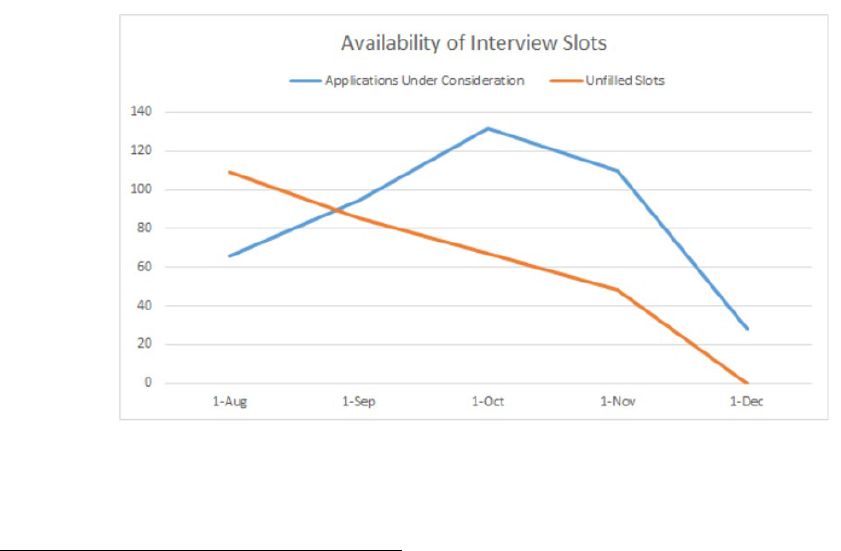
Colleges of Osteopathic Medicine Application Service (AACOMAS). Cadets are strongly
encouraged to send their applications on the day that the annual cycle opens for
submission to the respective services (usually in late May).
Data from Washington University demonstrating the advantages of early application
AMCAS Application – Major Components
Background Information
This section includes basic background information including name, date of birth, schools
attended, citizenship, etc.
Course Work
Applicants are required to enter all courses from every college and university attended.
This includes physical education classes, military science courses and military development
grades. College courses taken in high school programs that offer college credit through a partner
institution are listed; however, Advanced Placement (AP) courses are not included. The
calculated GPA consists of all classes that confer a grade and offer credit hours. For example,
military development (MD) grades are listed but not included in the GPA calculation because they
do not confer credit hours. The highest grade recognized by the system is an “A.” Cadets who
received grades of “A+” will find that their AMCAS GPA is lower than their USMA APSC.
Courses are verified by AMCAS after receiving transcripts. The length of time for verification
increases as the cycle progresses, presenting another reason to apply on the earliest possible
date (see graph below). Applications are returned for missing or incomplete information so
attention to detail is paramount. Further guidance on all sections of the application is available in
the AMCAS Applicant Guide.
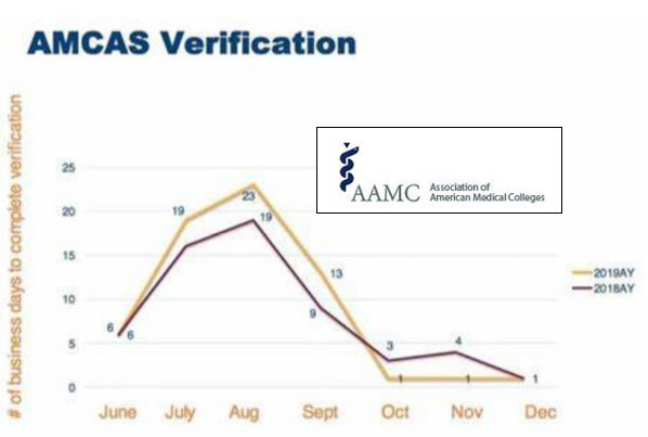
Transcripts
Cadets arrange for their USMA transcripts to be sent to AMCAS in coordination with the
Academic Affairs and Registrar Services (AARS) section in the Office of the Dean. Transcripts
should be sent as soon as possible following conclusion of the spring term. Application
verification cannot begin until transcripts have been received.
Work and Activities
This is an important section where applicants enter work experiences, extracurricular
activities, awards, research, chain of command activities, military training, etc. Individuals may
enter up to fifteen items; however, quality is more important than quantity. Applicants are not
required to meet the maximum number. Narratives of up to 700 characters are written for each
item. These should be thoughtful reflections highlighting leadership, teambuilding and the
development of qualities and attributes that will make the applicant a better physician. In
addition, three items may be designated as “most meaningful” and an additional 1,325 characters
are permitted to provide remarks.
Medical schools do not receive a separate resume or curriculum vita, so the Work and
Activities section provides a critical window into contributions outside the classroom. Applicants
are encouraged to demonstrate balance in their selection of entries. Clinical
exposure/shadowing, research and other experiences that relate to the practice of medicine
should be included. Activities performed while in high school should NOT be included unless the
applicant continues to contribute to the activity/organization in a meaningful way as an
undergraduate.
Letters of Evaluation
In this section, applicants enter information about their letter writers and indicate which
schools should receive recommendations. In most cases, the letters provided for the MPAC are
also used for medical school applications. Up to ten letters can be uploaded; however, cadets
are encouraged to submit five to seven letters, not counting their committee letter.
Committee letters are written by the pre-medical advisor for all endorsed cadets. Each
letter is sent to AMCAS as a “committee letter,” “letter packet” or both. A “committee letter”
includes a cover letter describing the program at West Point and an individualized letter unique to
the applicant. The “letter packet” consists of the same two documents as well as all other letters
of recommendation received by the MPAC and designated by the applicant. It is important to
check the requirements of the medical schools. Most institutions permit letter packets while some
only allow committee letters and individual letters. Cadets applying to medical schools that do not
accept letter packets must contact their letter writers individually to have their recommendations
uploaded. Since many cadets apply to some medical schools that accept letter packets and
others that do not, applicants often request both a separate committee letter and letter packet.
Medical Schools
Applicants list the medical schools where they wish to apply. The current Medical School
Admissions Requirements (MSAR), a document provided by AAMC, is an excellent resource to
guide the selection of schools. Cadets are advised to apply to 10–15 medical schools but are
permitted to apply to as many as they want. The nationwide average number of schools per
AMCAS applicant is sixteen.
Several guidelines are offered: 1) Apply to USU, even if it is not your top choice, 2) apply
to all of the state schools in your state (unless there are a very large number like in Texas and
California), 3) only apply to state schools outside your state if the MSAR confirms that they take a
reasonable number of out-of-state residents. Acceptance to medical school is all about “fit,” a
concept that transcends numbers alone. However, the metrics (GPA and MCAT score) should
guide applicants. Cadets are encouraged to divide schools into three categories: 1) “reach”
schools, 2) “in the zone” schools and 3) “comfortable by metrics” schools. There are no true “safe
schools” in the medical school application process. Applicants should carefully research the
medical schools to establish places that provide the best fit. Do not rely on reputation and
metrics alone. As stated by an expert advisor, “Speak to those in the know, honor your deal
breakers, align your passions/program and consider your support system.”
Essays
The personal statement is uploaded in this section. It is a 5,300-character (including
spaces) essay that introduces the medical school admissions committee to the applicant. The
completion of a well-crafted personal statement is an iterative process that takes considerable
time and effort. Most applicants write multiple drafts before arriving at their final product.
Meticulously edit the personal statement for errors in spelling, grammar, punctuation and create a
well-written and compelling essay.
Standardized Tests
MCAT scores will be directly loaded into applications by AAMC as soon as the results are
available.
Application Costs
The application fees in 2019 were as follows:
AMCAS: $170 for the first school, $40 for each additional.
TMDSAS: $185 flat fee for any/all schools.
AACOMAS: $195 for the first school; $45 for each additional.
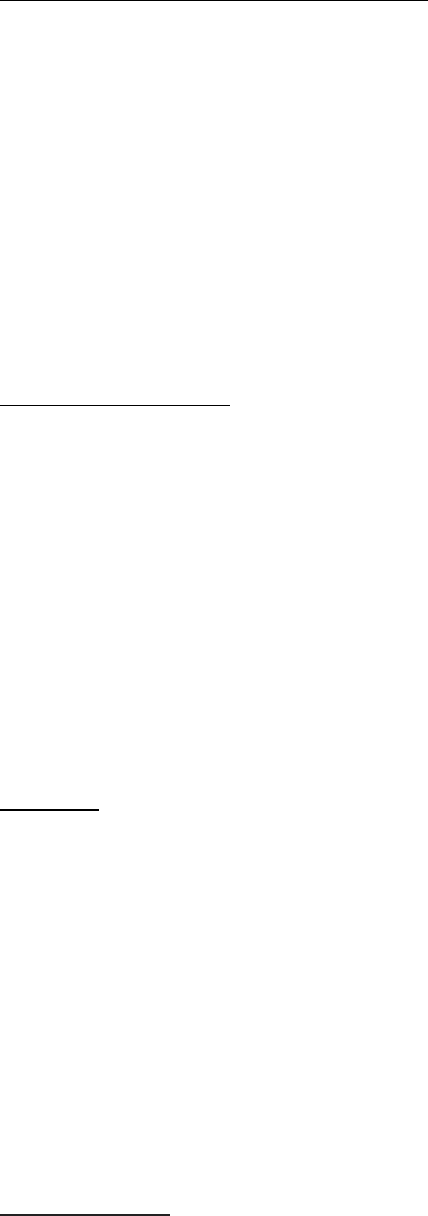
Allopathic and Osteopathic Medical Schools
Cadets may attend any accredited medical school in the United States. Schools fall into
two broad categories: allopathic and osteopathic. Allopathic (“M.D.”) schools comprise a system
in which medical doctors and other healthcare professionals (such as nurses, pharmacists, and
therapists) treat symptoms and diseases using remedies (ex: prescription drugs, radiation,
surgery). Allopathic medicine is also known as conventional medicine, mainstream medicine, and
Western medicine. Osteopathic (“D.O.”) schools are a system of institutions that promote the
body’s innate ability to heal itself. Osteopathy offers the benefits of modern medicine including
prescription drugs, surgery, and the use of technology to diagnose disease and evaluate injury. It
offers the added benefit of hands-on diagnosis and therapy through a system of treatments
known as osteopathic manipulative medicine. Applicants can apply to either, or both, types of
programs. Cadets seeking admission to osteopathic schools are strongly encouraged to learn
the philosophy and approach of osteopathy prior to preparing applications and attending
interviews.
Secondary Applications
Almost all medical schools require the completion of secondary applications. Some
schools require all applicants to complete them while others are selective and send requests after
a screening process. These applications are extremely important because they demonstrate how
an applicant aligns with a specific school. Cadets are encouraged to research each school
before completing the secondary application.
Timing is important. Since these submissions often represent the “rate limiting step” in the
application process, quick turnaround is imperative. Most medical schools do not change the
questions from one year to the next so most secondary applications can be completed well in
advance. The questions are easily accessible through the internet. Cadets are strongly
encouraged to complete the secondary applications for their top 5-10 schools well in advance in
order to expedite the process. When the applications arrive, simply re-check the questions,
adjust as necessary and submit as soon as possible.
Interviews
Cadets are encouraged to accept all interviews until they are accepted to medical school.
Once accepted, applicants can be more selective based on their prioritized lists. The costs of
travel and lodging are the responsibility of the applicants; West Point does not provide funding for
interviews. Cadets apply for special passes to obtain permission to attend the sessions. This is
generally a seamless process and any difficulties should be referred to the pre-medical advisor.
Interview formats are specific to each school ranging from traditional one-on-one
interviews to the multiple mini-interview, a format that uses many short independent assessments
to obtain an aggregate score of each candidate's soft skills. During 2020, schools are conducting
interviews remotely in response to COVID-19. Cadets are strongly advised to research the
school before attending the interview. Understand the mission of the institution and investigate
specific features of the medical school. Acceptance to medical school is all about “fit” and the
interview is the time and place to demonstrate suitability to attend a specific program.
Application Costs
Applying to medical school is a costly endeavor. Beyond the basic fees associated with
submission of the application, there are costs associated with the MCAT, interviews, etc. The
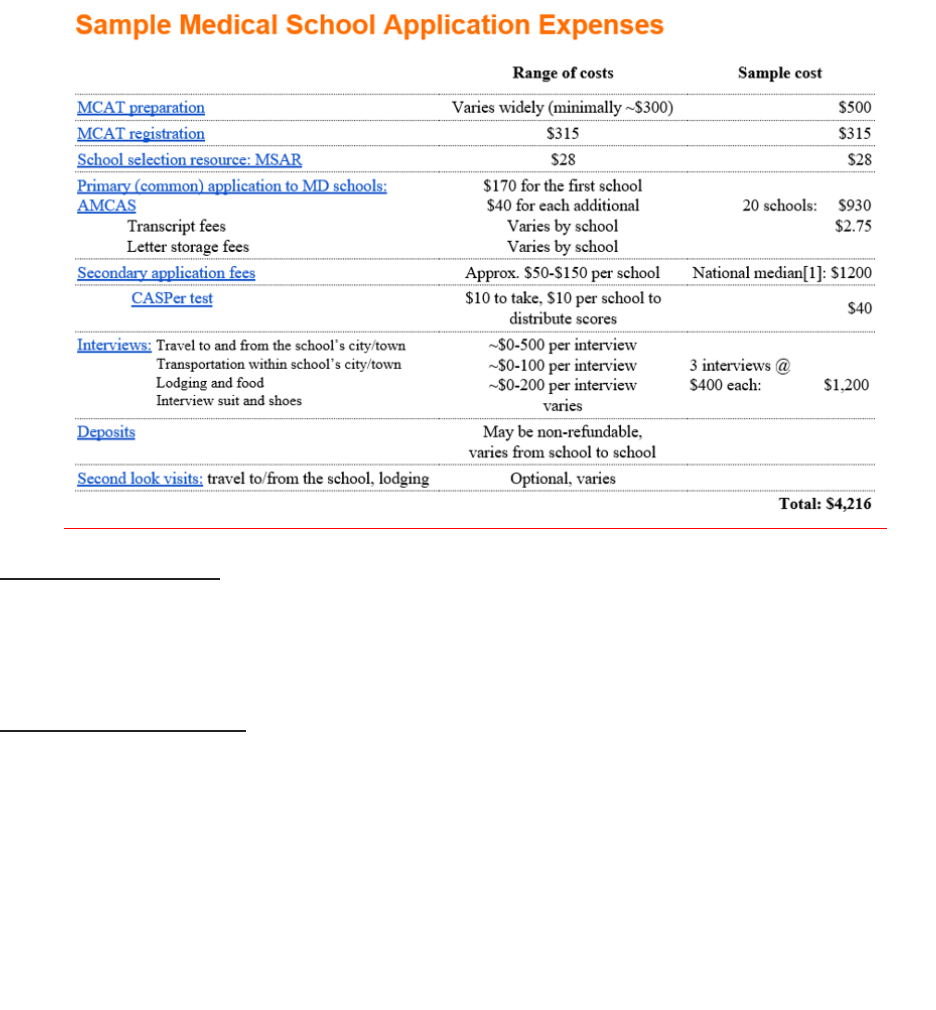
chart below provides perspectives on the financial outlays in calendar year 2020.
Tracking and reporting
Applications, interviews and acceptances are tracked by the pre-medical advisor and
reported to the Dean, CLS department and other agencies at West Point. Cadets are expected to
provide regular updates as they receive interview offers and acceptances.
Medical School Selection
Many medical schools employ a system of rolling admissions. By applying early, most
cadets gain acceptance to medical school during the first semester. In order to provide enough
time to issue orders and complete administrative requirements, cadets must receive an
acceptance by the end of the first week in May.
In 2019, AAMC introduced the AMCAS ® Choose Your Medical School tool to facilitate
enrollment management for medical schools by enabling applicants to communicate their
decisions about which schools they plan to attend. Final selections must be communicated to
AMCAS by 30 April using the tool. After that date, applicants can only select a different school if
accepted from a waitlist.
Medical School Scholarship Options
Uniformed Services University of the Health Sciences (USU)
The mission of USU is to support the readiness of America’s Warfighter and the health
and well-being of the military community by educating and developing uniformed health
professionals, scientists and leaders; by conducting cutting-edge, military-relevant research, and
by providing operational support to units around the world. USU is the nation’s federal health
professions academy — akin to the undergraduate programs at West Point, Annapolis and
Colorado Springs. Students are not charged tuition; they repay the nation for their education

through service. In many respects, USU’s curricula and educational experiences are similar to
those of civilian academic health centers, with one important difference: its emphasis on military
health care, leadership, readiness and public health set USU apart.
The F. Edward Hébert School of Medicine offers doctorate degrees in medicine and other
disciplines. Each year approximately 30 percent to 40 percent of incoming students have prior
service either as academy graduates, ROTC program participants or service members. The
remainder come from civilian backgrounds with no prior military experience. Medical students
remain on active duty throughout their education and are compensated as such. More than 60
percent of USU graduates willingly serve 20 years or longer.
Health Professions Scholarship Program (HPSP)
The Health Professions Scholarship Program (HPSP) provides paid medical education to
prospective military doctors (M.D. or D.O.) in exchange for service as commissioned medical
officers. HPSP was established under the 1972 Uniformed Services Health Professions
Revitalization Act and remains the main source of qualified healthcare personnel joining the U.S.
Armed Forces. Scholarship recipients are placed on inactive reserve status as second
lieutenants during their medical training. While on scholarship, the Army pays the following
expenses:
$2,300+ monthly stipend
$20,000 sign-on bonus
Books, equipment, other fees
Full tuition up to 4 years
Monthly allowance for food and housing
Officer’s pay during school breaks
Students are expected to serve 45 days of active training duty (ADT) each fiscal year. Upon
graduation, students are promoted to the rank of captain. Almost all HPSP graduates do their
residencies in the Military Healthcare System.
Active Duty Service Obligation (ADSO)
The Active Duty Service Obligation for cadets attending medical school varies depending
on the school, type of residency and fellowship training. The ADSO for attending USU is 7 years
while the obligation for attending a civilian school through HPSP is 4 years. Obligations are
served in chronological order: USMA – HPSP/USU – residency – fellowship. The West Point and
medical school ADSO’s are served consecutively; residency and USU/HPSP are paid back
concurrently. Fellowships generally add one year for each year of training. Examples are
detailed below:
HPSP
Short Residency (example: Pediatrics, Family Medicine, Internal Medicine)
WP + 16 years, ADSO = 9 years
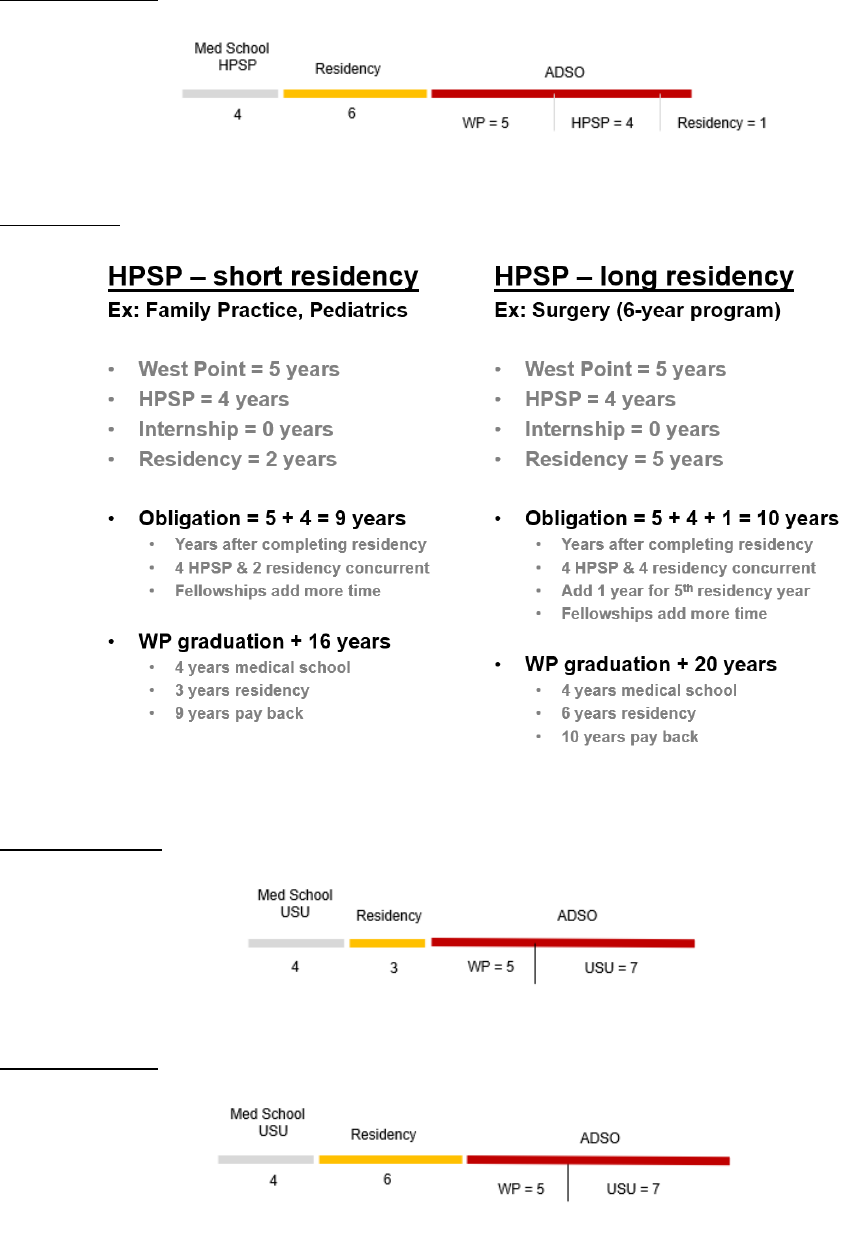
Long Residency (example: Orthopedics, General Surgery)
Calculations
USU
Short Residency
Long Residency
WP + 20 years, ADSO = 10 years
WP + 19 years, ADSO = 12 years
WP + 22 years, ADSO = 12 years
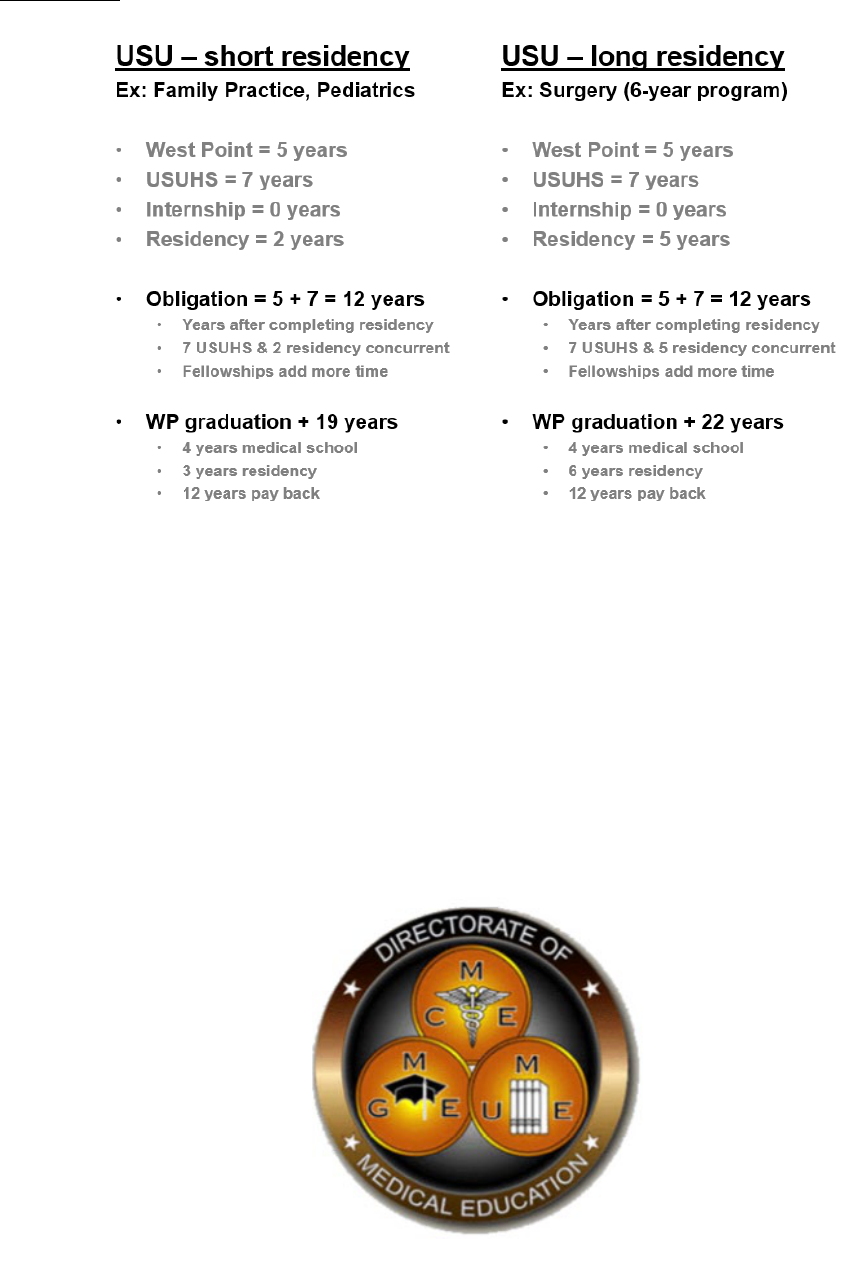
Calculations
Graduate Medical Education (GME)
Graduate Medical Education includes internship, residency and fellowship training. At any
given time, 29-33% of active duty Army Medical Corps officers are in GME. The Army provides
training at 11 military hospitals that offer 71 residencies. Fellowships are supported at civilian
and military institutions. All cadets are required to apply to the military residency match. Well
over 98% of USU and HPSP graduates do their training in military hospitals. All programs are in
good standing and accredited by the Accreditation Council for Graduate Medical Education
(ACGME). The first-time specialty board pass rate for the military programs is 96% (civilian 86-
87%).
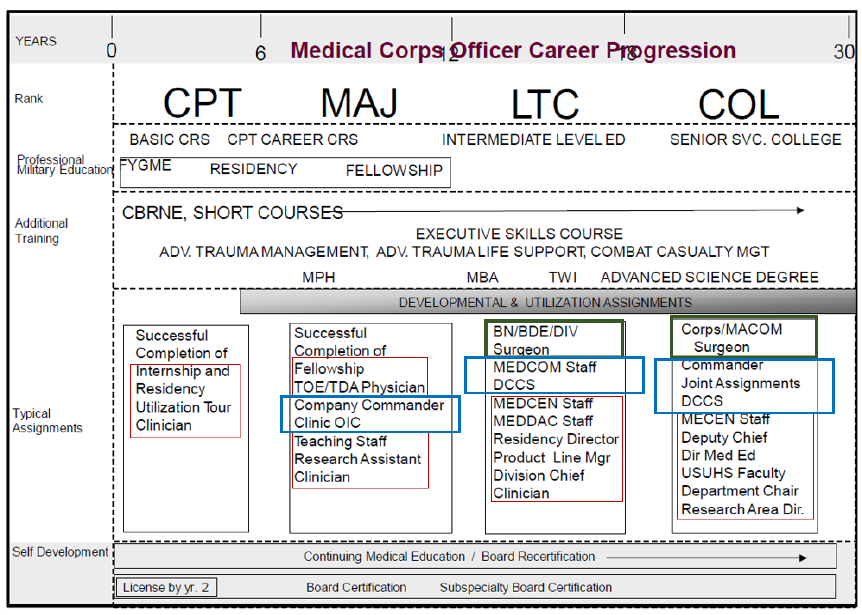
Career Progression
The Army provides opportunities for highly rewarding careers as healthcare professionals.
Three major tracks exist: 1) clinical, 2) operational and 3) administrative/command. Most
physicians spend time on more than one track throughout their careers. The following slide
highlights career progression for Army physicians.
Red = clinical, black = operational, blue = administrative/command
Questions
Questions regarding the material in this guide should be addressed to the pre-medical
advisor in the Office of the Dean.
